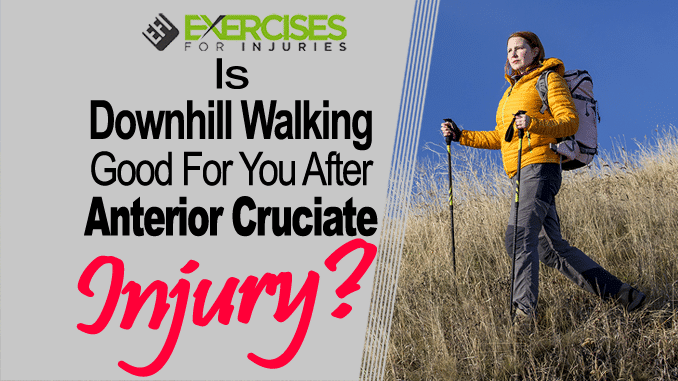
After anterior cruciate ligament and rehabilitation, many people find their average walking pace much more challenging. In some cases, it’s not possible to walk fast or climb stairs without pain. There are ways to improve strength and endurance while avoiding activities that aggravate the injured knee. Downhill walking is one of the best exercises for recovering from Anterior Cruciate Ligament surgery.
I was digging in the journals again and came across this journal article.
And I know it is an old one; from 1994.
I think the main point is a good one, plus I have been on a bit of a knee injury exercise, kick as of late.
I always look to improve the Exercise Rehabilitation of the Knee course.
If you have a client that has had Anterior Cruciate Ligament surgery, there is a lot to consider.
I have not thought about how the ACL graft will do when walking downhill.
Will walking downhill lead to re-injuring the ACL?
Keep reading to find out.
Downhill Walking After ACL Surgery
Post Anterior Cruciate Ligament surgery patients are recommended to engage in accelerated rehabilitation programs consisting of direct extension of the knee joint and full weight bearing. The protocol aims to improve knee extension, improve muscle strength recovery, decrease anterior knee pain and improve knee stiffness.
Disturbed proprioception occurring after an ACL injury and reconstruction can cause impairment or weakness of muscles stabilizing the involved knee joint. Because downhill walking can place a lot of stress on the problematic knee joint, with as much as 7 to 8.5 times the body weight, it must be avoided during the postoperative period to protect the ACL reconstruction. With knee shear forces exceeding the strength of ACL graft fixations, stabilization training of the quadriceps and hamstring muscles, the main stabilizing muscles of the knee, is essential. The rehabilitation process usually employs a full range of motion exercises first, followed by muscle strengthening, then balance and coordination exercises.
5 Key Points to Remember When Performing Downhill Walking After ACL Surgery
- The tibiofemoral shear force was 1.2 times body weight for males and 1.7 times for female subjects.
- The tibiofemoral compressive force was seven times for males and 8.5 times body weight for females.
- Knee joint shear force was 1000 N for a 70-kg person, which is greater than the 200 to 500 N strength typical of a standard ACL graft fixation.
- There is an increase in hamstring and gastrocnemius muscle activity to increase the stability of the tibiofemoral joint.
- Downhill walking should be avoided after Anterior Cruciate Ligament surgery, especially during the postoperative phase, to protect the ACL graft.
The Take Home Message on ACL Surgery and Hills
Downhill walking at a grade of 20% puts more shear force on the knee joint than the strength of an ACL graft. It is essential to avoid downhill walking after an ACL surgery.
You would think a 20% grade is very steep, but it is not. Most treadmills can quickly go to a 10% grade, which is not much. Plus, I know the little hills in my area of Surrey are at a greater slope than 20% grade in some areas.
This does not mean that someone with an ACL surgery should avoid hills forever, but just after the surgery, they should, and in time, hills can be added in.
Rick Kaselj, MS.





